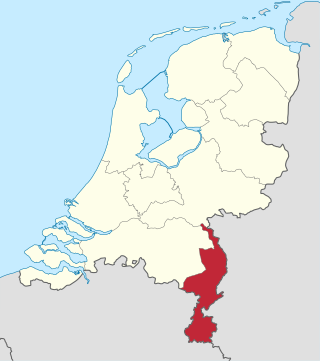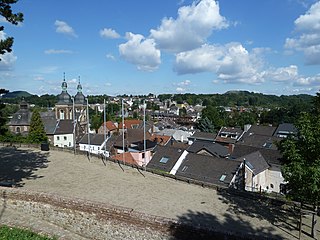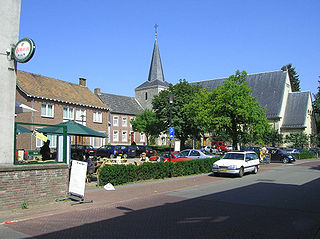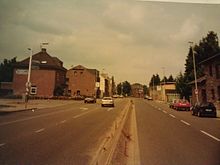
Limburg is the southernmost of the twelve provinces of the Netherlands. It is bordered by Gelderland to the north and by North Brabant to its west. Its long eastern boundary forms the international border with the state of North Rhine-Westphalia in Germany. To the west is the international border with the similarly named Belgian province of Limburg, part of which is delineated by the river Meuse. The Vaalserberg is on the extreme southeastern point, marking the tripoint of the Netherlands, Germany and Belgium.

Heerlen is a city and a municipality in the southeast of the Netherlands. It is the third largest settlement proper in the province of Limburg. Measured as municipality, it is the fourth municipality in the province of Limburg.

Simpelveld is a municipality and a town in the southeastern Netherlands. It is part of the municipal cooperative unit Parkstad Limburg.

Eygelshoven is a village, since 1982 part of the town of Kerkrade, in the southeast of the Netherlands, close to the German and Belgian borders.

Limburgish, also called Limburgan, Limburgian, or Limburgic, is a West Germanic language spoken in the Dutch and Belgian provinces of Limburg and in the neighbouring regions of Germany.

Ripuarian is a German dialect group, part of the West Central German language group. Together with the Moselle Franconian which includes the Luxembourgish language, Ripuarian belongs to the larger Central Franconian dialect family and also to the Rhinelandic linguistic continuum with the Low Franconian languages.

Herzogenrath is a municipality in the district of Aachen in the German state of North Rhine-Westphalia. It borders the Dutch town of Kerkrade, the national border in one section running along the middle of a main road and even directly through the centre of the cross-border Eurode office complex.

The Duchy of Limburg or Limbourg was an imperial estate of the Holy Roman Empire. Much of the area of the duchy is today located within Liège Province of Belgium, with a small portion in the municipality of Voeren, an exclave of the neighbouring Limburg Province. Its chief town was Limbourg-sur-Vesdre, in today's Liège Province.

Rolduc is the name of a medieval abbey located on the edge of the town of Kerkrade in the far south-east of the Netherlands. It is today a Roman Catholic seminary with an affiliated conference center. The abbey is a rijksmonument. It features on the official list of 100 top Dutch heritage sites, drawn up in 1990 by what is today the Rijksdienst voor het Cultureel Erfgoed.

Bocholtz (Dutch pronunciation:[ˈbɔxɔlts]; Ripuarian: Bóches is a town in the Dutch province of Limburg. It is a part of the municipality of Simpelveld, and lies about 7 km southwest of Kerkrade. Until 1982, it was a separate municipality.
Parkstad Limburg is a conurbation of seven municipalities in the southern part of the province of Limburg in the Netherlands. Consisting of Heerlen, Kerkrade, Landgraaf, Brunssum, Simpelveld, Voerendaal and Beekdaelen, the municipalities work together to improve public services, transport and housing on a regional level. This collaboration started in 1999. Within Parkstad, the city of Heerlen functions as the centre of economic and social activity, and to a lesser extent the cities Kerkrade and Landgraaf function in the same regard as regional hubs.
Southeast Limburgish is a cover term for the Ripuarian dialects spoken in Dutch Limburg.

The predominant language of the Netherlands is Dutch, spoken and written by almost all people in the Netherlands. Dutch is also spoken and official in Aruba, Bonaire, Belgium, Curaçao, Saba, Sint Eustatius, Sint Maarten and Suriname. It is a West Germanic, Low Franconian language that originated in the Early Middle Ages and was standardised in the 16th century.
Dutch dialects are primarily the dialects that are both cognate with the Dutch language and spoken in the same language area as the Dutch standard language. They are remarkably diverse and are found within Europe mainly in the Netherlands and northern Belgium.

The Meuse–Rhine Euroregion is a Euroregion created in 1976, with judicial status achieved in 1991. It comprises 11.000 km2 and has around 3.9 million inhabitants around the city-corridor of Aachen–Maastricht–Hasselt–Liège. The seat of the region has been in Eupen, Belgium since 1 January 2007. Within a wider context, the region is part of what is called the Blue Banana European urbanisation corridor.
Hard and soft G in Dutch refers to a phonetic phenomenon of the pronunciation of the letters ⟨g⟩ and ⟨ch⟩ and also a major isogloss within that language.

Eijsden-Margraten (Dutch pronunciation:[ˌɛizdəˈmɑrɣraːtə ]; is a municipality situated in the very south of the Netherlands. There it is located in the southeastern part of the province of Limburg.
Kerkrade dialect is a Ripuarian dialect spoken in Kerkrade and its surroundings, including Herzogenrath in Germany. It is spoken in all social classes, but the variety spoken by younger people in Kerkrade is somewhat closer to Standard Dutch.
This article covers the phonology of the Kerkrade dialect, a West Ripuarian language variety spoken in parts of the Kerkrade municipality in the Netherlands and Herzogenrath in Germany.

























